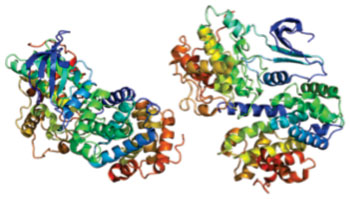Bile Acids Regulate Expression of a Tumor Suppressive MicroRNA
By LabMedica International staff writers
Posted on 15 Apr 2015
A recent paper explained how the tumor suppressive microRNA miR-22 is regulated in cells lining the gastrointestinal tract and how defective regulation leads to various types of cancer.Posted on 15 Apr 2015
MicroRNAs (miRNAs) are fragments of RNA about 20 nucleotides long that block gene expression by attaching to molecules of messenger RNA (mRNA) in a fashion that prevents them from transmitting the protein synthesizing instructions they had received from the DNA. The miRNA miR-22 has long been known for its ability to suppress cancer, but how this action was regulated was not well understood.

Image: Structure of the CCNA2 (cyclin A2) protein (Photo courtesy of Wikimedia Commons).
Investigators at the University of California, Davis (USA) recently published a study that had been designed to understand the regulation of miR-22 and to identify additional downstream miR-22 targets in liver and colon cells. To this end they worked with a population of mice that had been genetically engineered to lack the gene for the bile acid receptor, farnesoid x receptor (FXR), which moderates bile acid and cholesterol metabolism. Mice lacking FXR spontaneously develop liver cancer. The investigators also examined the expression of miR-22 in human liver cancer and colon cancer specimens.
Results published in the March 6, 2015, issue of the Journal of Biological Chemistry revealed that miR-22 was transcriptionally regulated by FXR through direct binding to an invert repeat one motif located from 1,012 to 1,025 base pairs upstream from miR-22. Among the studied primary and secondary bile acids, chenodeoxycholic acid, which has the highest binding affinity to FXR, induced miR-22 levels in both Huh7 liver and HCT116 colon cells in a dose- and time-dependent manner.
Cyclin A2 (CCNA2) was identified as a miR-22 novel target in liver and colon cancer cells. The sequence of miR-22, which is conserved in mice, rats, humans, and other mammalians, was found to align with the sequence of 3′-UTR of CCNA2. Chenodeoxycholic acid treatment and miR-22 mimics reduced CCNA2 protein and increased the number of G0/G1 Huh7 and HCT116 cells. In mice genetically engineered to lack FXR, reduction of miR-22 was accompanied by elevated hepatic and ileal CCNA2 protein, as well as an increased number of hepatic and colonic Ki-67-positive cells. In humans, the expression levels of miR-22 and CCNA2 were found to be inversely correlated in liver and colon cancers.
"There are quite a few molecules present in the gastrointestinal (GI) tract that regulate miR-22," said senior author Dr. Yu-Jui Yvonne Wan, professor of pathology and laboratory medicine at the University of California, Davis. "If so many chemicals in the GI tract can regulate miR-22, it must be physiologically significant. We needed to better understand the molecules that regulate miR-22 in cancer, as well as the pathways miR-22 controls."
The investigators also found that miR-22 was activated by vitamin D3, which can reduce the toxicity of hydrophobic bile acids. "People who are obese, or eating a high-fat Western diet, tend to have dysregulated bile acid synthesis," said Dr. Wan. "When that happens, FXR can be inactivated, potentially decreasing the level of miR-22, increasing the expression of cyclin A2 and disrupting the cell cycle. So this pathway may play a role in Western diet-associated carcinogenesis. I am not so sure miR-22 is all good. We do not know what it will target in normal cells. Our next step is to identify more miR-22 effects."
Related Links:
University of California, Davis














